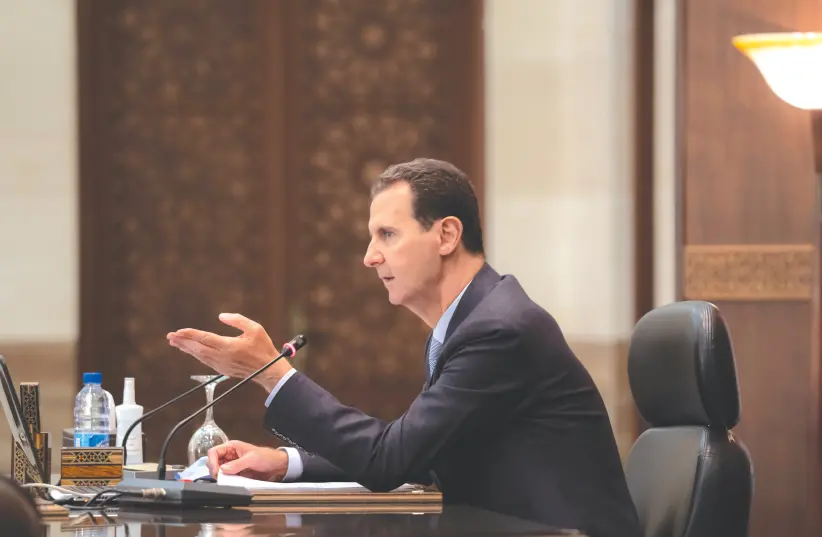MIDDLE ISRAEL: There are currently two main blueprints for postwar Syria: Assad’s and Vladimir Putin’s.
Bibi Netanyahu can only dream of this: 21 straight years in power, absolute electoral victories, no coalition talks, no judiciary to battle and no media to curse.
The side effects of this political monopolism – a civil war’s carnage, displacement, dispossession, and biblical-scale butchery – have done nothing to make its beneficiary depart. On the contrary, Bashar Assad is sitting pretty even as his civil war now enters its 11th year, while his eternal presidency is set to enter its fourth seven-year term.
The man who killed more Arabs than anyone else in modern history is going nowhere. Worse, the efforts to craft a postwar Syria have no guiding idea, since its multiple belligerents and patrons all fail to prescribe the only medication that can cure Syria’s sectarian disease: divorce.
THERE ARE currently two main blueprints for postwar Syria: Assad’s and Vladimir Putin’s.
Having borrowed one page from Francisco Franco, who won the Spanish Civil War by unleashing foreign air forces on his own cities, Assad now plans to emulate Franco’s political act as well, first by reclaiming his lost territories, then by asserting his authoritarian rule.
That means restoring the prewar anomaly whereby the Alawite minority, less than 15% of the population, ruled the Sunni majority of some 60%, if one counted the Sunni Arabs alone (counting the non-Arab Kurds, the Sunnis were some 70%).
Meanwhile, Assad is using the refugee crisis to reduce the Sunnis to a minority. That is why he passed legislation engineered to dispossess the Syrians he has already displaced, and that is why he let Iran move foreign Shi’ites into houses abandoned by Sunnis who fled his howitzers’ shells.
Putin’s plan is less cynical, suggesting some transfer of power from the presidency to the legislature and the creation of a federation, all of which would legitimize the opposition and give minorities some voice.
Assad, however, rejects even this mild reformism, even at the cost of irritating his Russian patron, not to mention the UN, whose Geneva-based constitutional talks Assad has been stalling.
Other players have no postwar vision at all. Turkey focuses on sabotaging Kurdish autonomy. America focuses on nurturing it. The Arab League has effectively vanished while talks of Syria’s future sailed far from Arab lands, to Geneva, Astana and Sochi. Europe’s diplomats also disappeared, even though the war landed millions of refugees on their unwelcoming shores.
Meanwhile, the economy remains devastated because Russia doesn’t have the billions Syria’s reconstruction demands, and the West won’t put cash anywhere near Assad’s pockets.
It can all change if two players – the Arab League and Russia – would openly recognize the war’s overarching cause: the Assad dynasty’s minority-rule system.
MODERN SYRIA was mapped by Europeans who forced sectarian antagonists into one political bed.
Though interspersed with other minorities – the non-Sunni Druze and assorted Christian communities – the main sectarian division lies between eastern Syria, where most Sunnis live, and the west, where the Alawites are concentrated along the Mediterranean coast and the Nusayriyah Mountains to its east.
The Sunnis are most of the war’s 13.1 million refugees, including 6.6 million within Syria; they were the better-equipped side’s targets. Now the surviving targets hate Assad and his tribe, and their critical mass will remain in Syria no matter what he plots. They will need all the jobs, housing and dignity Assad will never deliver. If forced again into his rule, vengeance will fester and violence will resume.
The solution must therefore be partition: an Alawite state in western Syria and a Sunni state in the east, the way Kosovo, East Timor and South Sudan were carved out of Serbia, Indonesia and Sudan, under similar circumstances.
To thrive, East Syria will need legitimacy and livelihood. For both reasons, its creator should be the Arab League, while Moscow guarantees the Alawites’ grudging acceptance. Washington and Brussels will happily back the project from afar.
The Arab League has never in its 76 years shaped history. The Syrian chaos brings its irrelevance to a new low, as it watches helplessly while Turkey occupies Syria’s north, Russia parks in its west, America camps in its east, and Iranian-paid militias dot its hinterland.
Now the Arab League – meaning Egypt and Saudi Arabia – can reinvent Syria and thus seize the Arab future.
East Syria’s capital, borders, and sectarian arrangements will be for its Arab builders to engineer. However, its prospective land’s aridity is a given, despite containing a segment of the Euphrates. Prewar droughts were what sent thousands of Sunni farmers to the cities where Assad’s apathy left them jobless, and fueled for revolt.
East Syria will overcome this by desalinating and piping water from Saudi Arabia via Jordan. It’s feasible.
Saudi Arabia is a desalination power, and East Syria’s 1,100-km. pipeline will be shorter than the Trans Arabian Pipeline that once led Saudi oil from the Gulf to Beirut. Newly abundant water will thus breed farms, cash, industry and new towns that will transform the Syrian Desert.
While created by the Sunni Arab powers, East Syria’s emergence will serve the interests of all the powers currently embroiled in Syria, except Iran.
Turkey’s construction industry would spearhead East Syria’s buildup, an opportunity that can make Ankara tolerate a Kurdish autonomy within East Syria. Russia, rather than be recalled as the country that helped subdue Syria’s Sunnis, will be recalled as the country that green-lighted their liberation.
The US will get a north-south Sunni axis that will undo the east-west Shi’ite belt that Iran is laboring to stretch between Beirut and Tehran. And Europe will get fewer refugees flocking to its shores.
The Yugoslav ethnic federation fell apart 11 years after its founder Tito’s death. Syria’s minority-rule republic also fell apart 11 years after the death of its founder, Hafez Assad. It’s time his polity joined him in his grave.
 Eurasia Press & News
Eurasia Press & News




